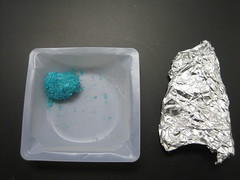Today we kicked off class finishing our Copper and Silver Nitrate Lab. If you somehow lost your lab, here is a link. We went to go get the masses of the silver left in our beakers. (hopefully you didn't spill all of your silver in the sink). After massing our silver, we went back to our desks and we wentthrough how to do the post lab.
In the post lab, you have to find the mass and moles of copper wire that reacted. Then you have to find the mass and molesof the silver metal that was produced in the reaction. Using this data you have to find a mole ratio between the two elements. With this mole ratio, you have tocreate a balanced chemical equation for the reaction. We used this example in class....
If the mole ratio between silver and copper was 3 Ag : 1 Cu, then the balanced chemical equation for this reaction would be....

The whole point of this lab is to find the balanced equation. Oh and of course also to make silver for Mr.Lieberman to sell. So that was pretty much the first half of class.
The second half we looked at a single replacement reaction between Aluminum and Copper Chloride.
The Reactants, Copper Chloride on the left (we dissolved it in water before reacting it) & Aluminum foil
The reaction over time
What happened was the Aluminum bonded with the Chloride and that left the copper (the redish chunks at the bottom) alone by itself. As you can see the liquid went from blue to clear because the copper was taken out of the liquid.
The balanced equation for this reaction is... 

To begin with, we had .66 grams of Al and .64 grams of  .
.
 .
.A limiting reactant is the reactant that runs out first, or the reactant that creates the least product. The balanced chemical equation and the mass of the reactants are crucial to finding limiting reactants. There are two ways to find the limiting reactant in this case....
Method # 1 : This is the way where we find out how much  is needed to react with the .66 grams of Al.
is needed to react with the .66 grams of Al.
 is needed to react with the .66 grams of Al.
is needed to react with the .66 grams of Al.
This shows that you need 4.9 grams of Copper Chloride to react with .66 grams of Aluminum. Now you maybe thinking, "OH MY GOD!!!! WE ONLY HAVE .64 GRAMS OF COPPER CHLORIDE!!!!!" Well, congratulations my friend, you have just found the limiting reactant. Since there isn't enough copper chloride to react with .66 grams of aluminum, the copper chloride will run out first, making the copper chloride the limiting reactant. However, this way is not that great of an idea if you need to find out how much of a product is produced. For this, you probably shoud use method #2.
Method #2 : In this method, you take each of the two reactants and find out how much of the product that reactant produces.

(.66 grams of aluminum produces 2.32g of copper)
now you do the same thing with the other reactant

(.64 grams of Copper Chloride produces .30 grams of copper)
Since Copper Chloride produces less copper than Aluminum does, Copper Chloride is the limiting reactant. Also, with this method, you figured out that .30 grams of copper was produced by this reaction.
The last thing we learned how to do was find how much of the excess reactant will be left. Since we know that .30 grams of copper will be produced, we want to find out how much aluminum is needed to make .30 grams of copper. Than we subtract that amount from the amount of aluminum originally present, and, HA-ZAA! you have your excess reactant. Heres the work...

.085 grams of aluminum is needed to make .30 grams of Copper, so then you do .66 -.085=.575 There will be .575 grams of excess aluminum leftover.
That pretty much sums up todays class period. There is a quiz tomorrow so you better know your stuff, hopefully this post helped you learn your stuff. Also today Liebs gave us a homework sheet at the beginning of class which is like always due on the test day. If you forgot to pick it up or were absent today, you can find it here. It is called 02_stoichPrac.
Thats is for me guys. The next scribe will be Senor Trevor B. Have fun, you have five days to do this, so it better be good.


No comments:
Post a Comment